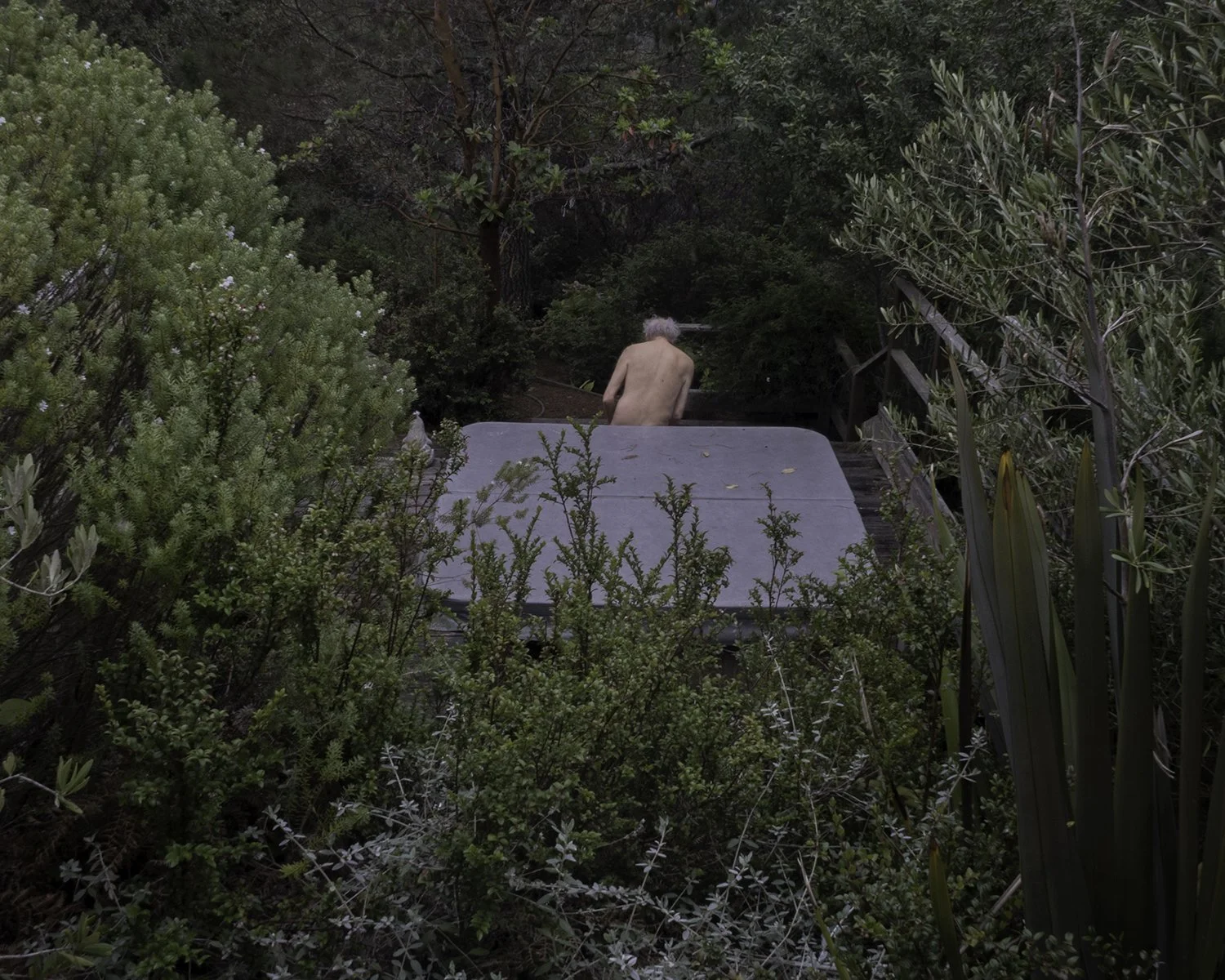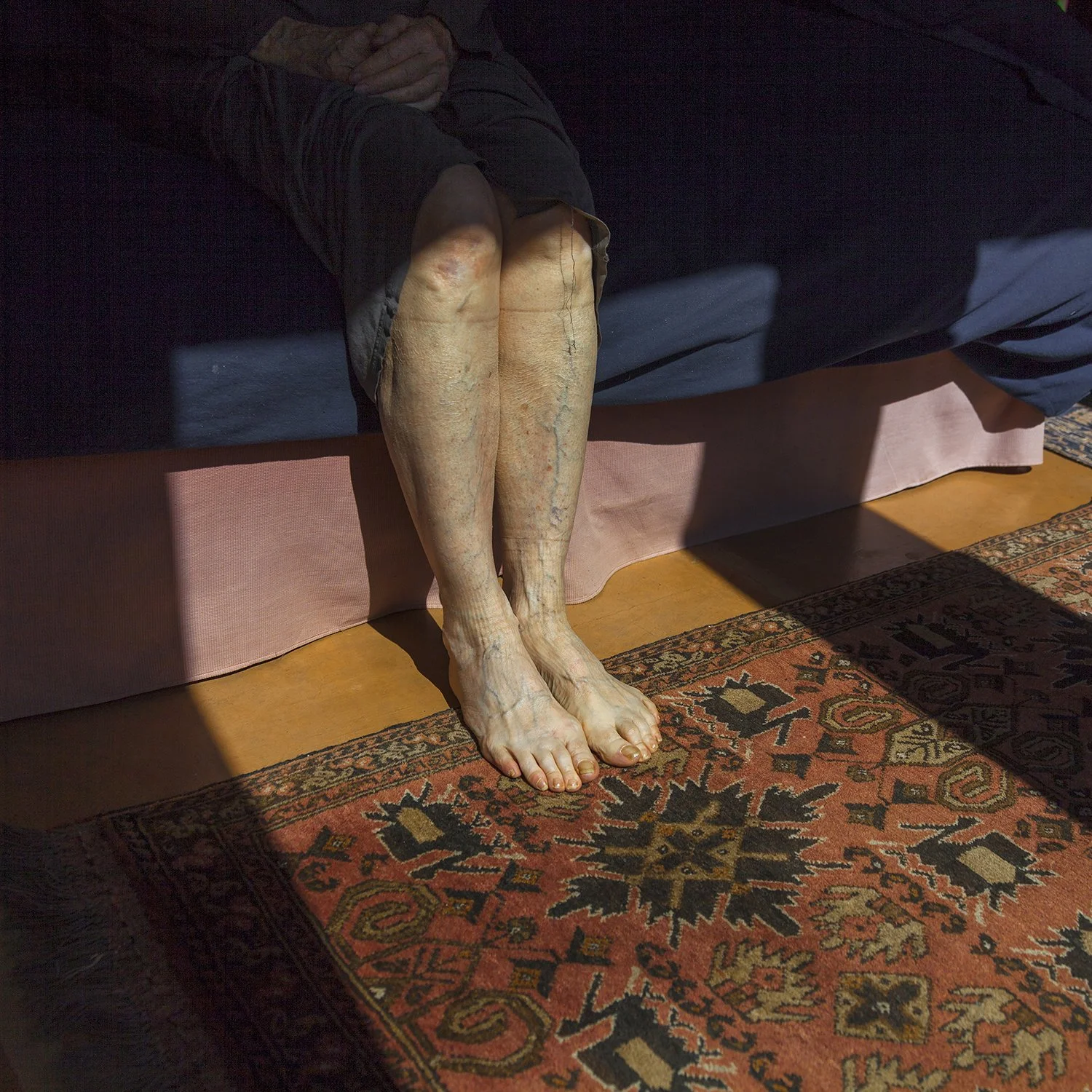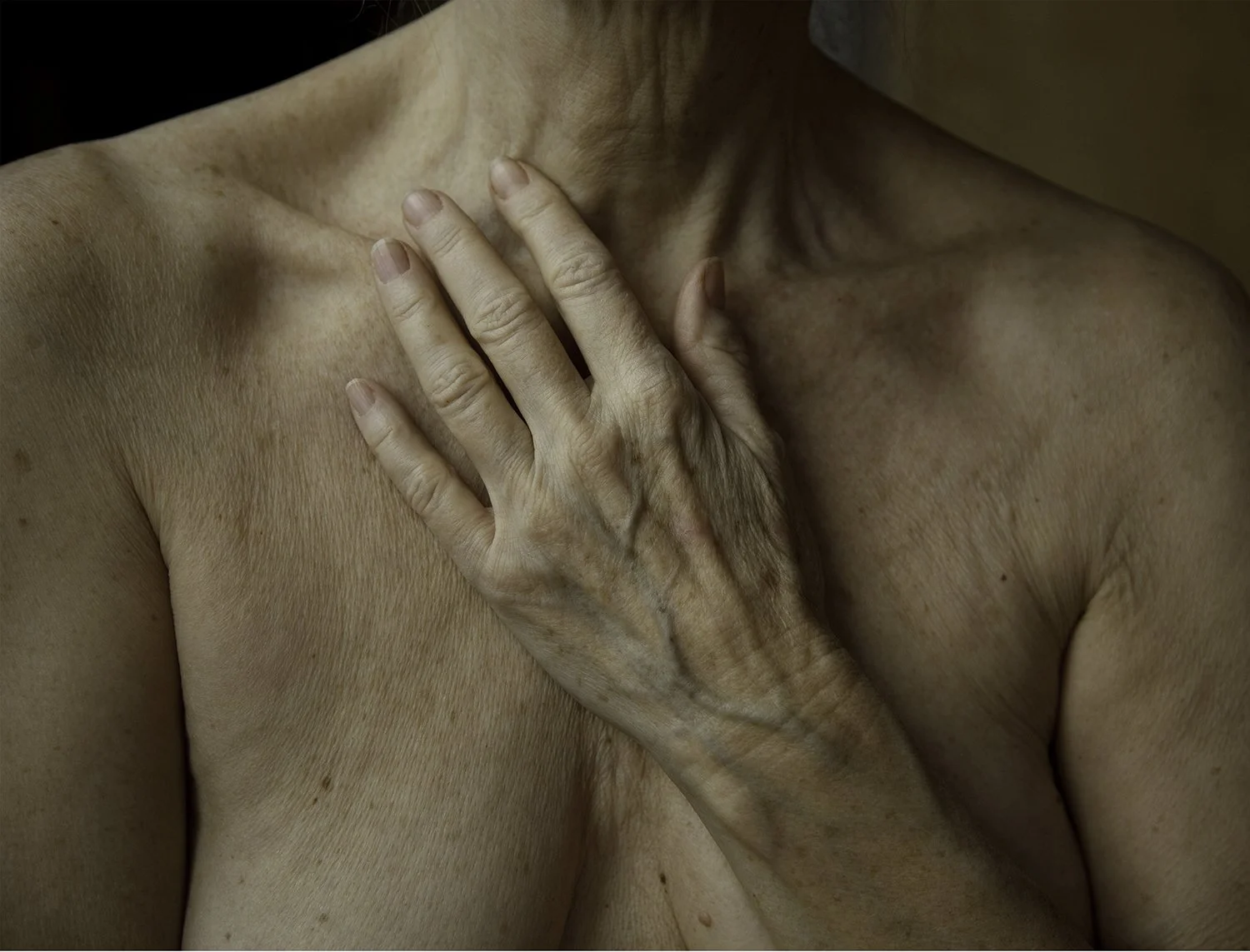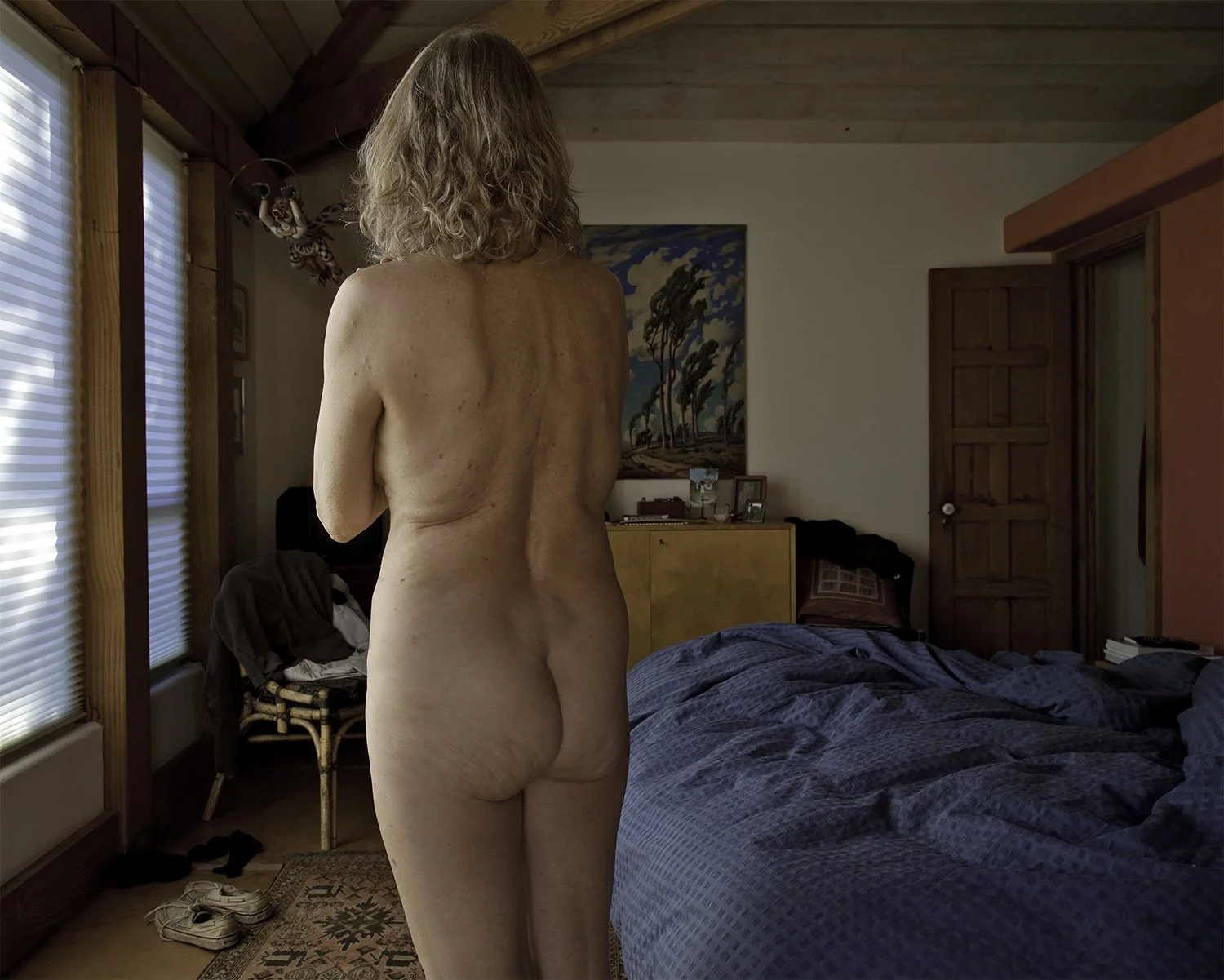Arms Embrace, 2010 © Marna Clarke
The photographer’s 12-year long project visualizes aging bodies, intimacy, and hard-fought self-acceptance.
The story of Narcissus warns us against gazing too long at ourselves. The Greek mythical character, who eschewed real-time romantic attachments after falling in love with his own reflection, models existential detachment that undermines a full and happy life. If real and alive today, what would he say about our obsession with social media and all that it reports back to us?
Time As We Know It, Marna Clarke’s long form documentary project, doesn’t stray into navel or other self-sabotaging gazing. Instead, it marks the passage of time as it registers on our bodies. Self- and combined portraits of Clarke and her partner Igor convey the comfortable intimacy of a long term relationship that blossomed later in life. Gray hair and wrinkles and all the living that produced them are, in her compositions, treasured gifts, and provide balance to pervasive media messaging about youth and beauty.
Humble is pleased to highlight Clarke as one of our ten standouts from the 2021 Critical Mass Top 50 finalists. Be sure to check out a virtual exhibition of Time As We Know It at SF Camerawork before it closes on May 24th.
Roula Seikaly in conversation with Marna Clarke
Red Towel, 2012 © Marna Clarke
Roula Seikaly: For anyone who doesn't know the origin of the series Time As We Know It, could you describe what motivated it, and how or if it has changed over 12 years?
Marna Clarke: When I turned 70, I felt as if I had rounded a corner and seen the end of my life, not close but visible in the distance. I didn’t feel old…did I look old? Not satisfied with just a glimpse in the mirror, I decided to photograph myself from head to foot. I set my camera on a tripod, bought a small device that when pushed would electronically trigger the camera shutter to open and close. Armed with this equipment, I began to record my face, hair, eyes, hands, shoulders, torso, feet, back, legs, my whole body basically, unclothed. I had spent most of my life thinking I was big when I wasn’t. These photos put that misconception to bed. The photographer in me sought out beautiful light for these images and composed them carefully to make them interesting.
Hottub, 2016 © Marna Clarke
Seikaly: At what point did you show them to others?
Clarke: I printed them and showed the prints to a small class I was taking with photographer Janet Delaney in her home. We were to bring in new work every month, and this was my new work. I was curious what the feedback would be…and nervous about sharing such intimate work. The response was very positive; I was encouraged to keep going.
Seikaly: How did your process develop from there?
Clarke: I continued to experiment with different lighting, different poses, eventually including Igor, my partner, as well, with and without clothing. These images were about the physicality of our bodies and not intended to be alluring. I felt strongly that I didn’t want our genitals to show.
I then began to set us up, mostly clothed, in domestic scenes. If I saw something happening as we went about our daily business that I found particularly unusual or poignant, I would grab my camera and record it right then, or I’d save the idea and execute it soon after. Always I took several shots changing positions and making adjustments.
90th Birthday, 2019 © Marna Clarke
Seikaly: There’s an incredibly variety to approach, perspective, poses, etc…
Clarke: I would look at the screen on the back of the camera and check for focus, lighting, movement, extraneous distracting elements that I could eliminate. At some point I bought a digital cable release that I could program to fire the shutter at regular intervals. So, for instance, I could set it to fire every 5 seconds. Then I could enter the scene, and just let the equipment do its thing until I manually stopped it.
I would rearrange myself or Igor or both and get several shots from which to choose at least one good one. This was not always a smooth experience as I might take longer than expected to get everything the way I wanted it…and though Igor was cooperative for the most part, there were moments when he wasn’t.
From starting about our physicality through telling stories, these photos show our changing as we’ve aged, exactly what I’d hoped they would do.
Legs, 2020. © Marna Clarke
Seikaly: You write about losing control, or questioning the illusion of control, as you age. Does photographing yourself and your partner feel like reclaiming elements of control?
Clarke: I think you must be referring to my statement. “Growing older has occasioned a gradual letting go of things I’ve taken for granted all my life. my youth, figure, memory, mobility, hearing. So much is out of my control; perhaps it always was, but I was blind to it.”
Photographing us now reclaims an element of control in the sense of play-acting…we control because we’re into theater, into re-creating experiences of our lives.
Growing older demands an acknowledgement of the truth, be it physical or mental limitations, or personal situations, in order to live with a sense of realistic expectations, an acceptance of not having complete control and learning to live with that knowledge, with change, with what we can control. I think change is especially difficult as we age. The familiar is so comforting. Change isolates us even more and reminds us of being old. Technology is a perfect example of this.
I don’t have any control of my physical age. I take a lot of supplements and do a lot of exercising in order to “control” my weight, mobility, hearing and memory, but I’m still growing older, losing a certain amount of mobility, memory and hearing, my body shifting into a more mature version of its youthful shape. Was it an illusion that I thought I could stop the progression of age, to thwart it from happening. I’m sure I’ve helped postpone some of the losses a bit, but aging takes its toll on us eventually.
Post-Cataract Surgery, 2021. © Marna Clarke
Seikaly: In the Autumn project statement, you write about shyness and how it informs interaction with your portrait sitters. How do you overcome that in order to be both subject of and unclothed in this series?
Clarke: The shyness around taking pictures of others comes from feeling uncomfortable asking them to give me their time and attention, to be willing to have vulnerable moments with me that will potentially be available for public viewing without their having any say in what is chosen. I want them to be present, not posing or
smiling which is a way of hiding. I feel the pressure of getting what I want within the time frame of our session together (is it in focus, exposed properly, unique, poignant, honest, does it give a glimpse into who they are?). I don’t always get what I want in one session and so I discovered by telling them from the get-go that it might take a couple of sessions until I get it has relaxed my anxieties (and theirs as well) and helped me alleviate the shyness.
None of this exists when I photograph myself. I can take as long as I need to get what I want. I am in control of all of it. If I really flub, no one needs to know. I’m not inconveniencing anyone. I read somewhere that that’s what made Cindy Sherman use herself as a subject or model. I understand that. The unclothed factor is a whole other matter. I grew up knowing what my parents looked like naked. We didn’t go around without clothes at home, but we also didn’t try to hide our bodies. I’ve photographed myself naked many times through the years. I was introduced to nude beaches in my late thirties.
Embrace, 2013 © Marna Clarke
Seikaly: Can you talk a bit more about the role nudity – and comfort around it – plays within the process?
Clarke: Igor and his family are even more relaxed about being unclothed. Our culture, though, is not, probably from our Puritan foremothers and fathers. In the beginning of my exploration at age 70, I was not shy about taking the nude pictures, but I was shy about showing them to the class I was attending.
My hesitancy was mitigated somewhat because we were all women and I figured there were no messages being misconstrued through eyes perhaps seeking sexual innuendos. When some of these early nude images appeared in a Feature Shoot article in late 2014, I found out what a taboo they were from the comments submitted.
I now rarely photograph nudity. The use of it has to make sense, to be natural to the scene, and genitals not visible…they’re too distracting and unnecessary for the impact of the image.
Changing Lightbulb, 2019. © Marna Clarke
Seikaly: Has this project influenced your relationship with your partner?
Clarke: It has certainly enriched it enormously…providing lots of challenges and enabling us to grow as a couple. I was once told that we unconsciously get into relationships to learn about ourselves, and I would have to agree for myself. By inviting Igor into my own creative project, I have had to deal with his reluctance to be seen as an old man with an appearance he doesn’t always like.
I applaud his courage and willingness to be vulnerable. I also have that same aversion to a degree, but I’m also the creator and curator so my job is to choose what’s needed and appropriate. I had made an agreement with him in the beginning that I wouldn’t include anything without his permission. There have only been a few images that were cut.
I think Igor understands what the project is all about because he’s trying to deal with aging and death. He has tough moments with what lies ahead for him. I feel this project has given us a safe place to talk about some of the issues we’re both facing.
Garland Hanging, 2021. © Marna Clarke
Seikaly: How do audiences relate to this series? Has anyone told you how they feel about aging after looking at these images?
Clarke: I have a guest book people sign at my exhibitions and I’ve just reviewed comments from the three shows I’ve had locally of this work from 2013-2019. Lots of comments about my courage and honesty interspersed amongst those of thanks for taking on this topic. Many older people expressed gratitude for my
bringing to the forefront the aging issue, for their feeling “seen” by the work. Several remarked about being touched by seeing what they themselves are going through. One woman at the first opening came up to me, hugged me and cried, thanking me for doing this work – and she was a therapist most likely in her 50s. All of this positive feedback from friends, gallery visitors, and fellow artists were written in a public book and signed.
Squats, 2021. © Marna Clarke
Seikaly: That’s great and encouraging! On the flip side, given the subject matter, have there been any negative responses?
Clarke: With media, comments can be anonymous and therefore encourage temptations to unload juvenile, hurtful, vulgar remarks. I’m learning to turn a deaf ear to those comments but it’s taken me a while. I had to withdraw for a year or so to examine my reactions and gain a perspective about which criticisms were helpful and which not.
I knew I had crossed a boundary of my mother’s regarding nudity – photographing myself unclothed in the first place and then showing the photo in public. Her silent disapproval still hangs out in my mind; it’s one more thing I’m learning to disregard. For the most part I’ve become aware of the impact this work has had on older people, how hungry they/we are for acknowledgement. And I’m learning that the nudity being non-sexual can be appreciated for its naturalness and taken in stride. It has been an interesting, distressing and expansive journey for me.
Two Glasses to See, 2021. © Marna Clarke
Seikaly: Your work really stood out to us among the many 2021 Critical Mass finalists. Critical Mass is a major investment of time and money and it’s incredibly competitive. Had you applied in the past?
Clarke: The first time I applied to Critical Mass was in 2014 with a very young Time As We Know It series. I had been encouraged to enter by a couple of my “Photo Angels,” women who teach photography or run galleries and support my process and work. I got in the top 200 and received invitations to have my work shown in Feature Shoot, to be interviewed by a radio show in Montreal, Canada, and to be interviewed by a newspaper reporter in Ireland. There were several other offers but by then I had been traumatized by the reaction to my showing elder nudity and found myself shut down.
Seikaly: What swayed you to apply again in 2021?
Clarke: I have taken several years to sort out the reactions I had then and to work on my emotional strength and perspective to get back on the horse again, so to speak. I decided to enter in 2021 with this more mature, expanded series. I had been observing how much it meant to several photography friends who had made it in the top 50, and I thought I had a good chance.
Hand on Chest, 2010. © Marna Clarke
Seikaly: Aside from this Humble Arts Foundation interview, have opportunities come out of Critical Mass?
Clarke: Yes! Here’s a list of the opportunities that have come from participating in Critical Mass:
1. Two images in Mockingbird publication.
2. Online exhibition at SF Camerawork.
3. Interview with Executive Director of Griffin Museum Crista Dix for a possible
exhibition there.
4. One image in International Juried Show at Center for Photographic Art
that the jurors had seen in the Critical Mass Top 50.
Seikaly: Has being selected for the Critical Mass Top 50 of 2021 influenced how you think about making work, or your creative process?
Clarke: The honor of being one of the Critical Mass Top 50 artists has boosted my self-esteem enormously! I have entered Critical Mass three times and been selected for the top 200 each of these times. This is the first time reaching the Top 50. Almost immediately, I held my head a little higher! As the realization sunk in, I could feel a huge shift inside me that was so very affirming and welcome. I felt as if my body was filling up with the sweet warmth of self-acceptance and love. I felt validated, that my work was validated. I’m feeling motivated to push this work while it’s getting acknowledged.
Back in Bedroom, 2011. © Marna Clarke
Seikaly: That’s wonderful!
Clarke: Making work is a lonely activity fraught with a lot of self-doubt and this award helps alleviate that doubt. Getting it was a booster shot of adrenalin. I began to plan new scenarios, armed with the confidence that I know this work and can keep observing and trying new shots and settings sure that somewhere in me the skills and intelligence and vision will bring forth more images to round out my experience of growing old.













